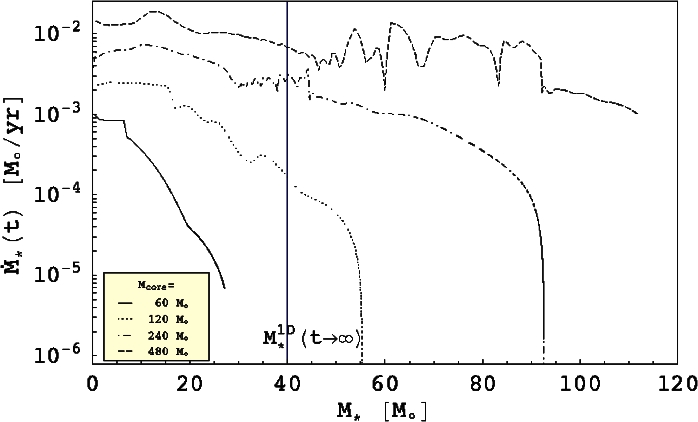| EPoS Contribution |
|
Overcoming the radiation pressure barrier in the formation of massive stars via disk accretion
Rolf Kuiper Max-Planck-Institut für Astronomie, Heidelberg, Germany | |
| We investigate the radiation pressure problem in the formation of massive stars using a newly developed frequency dependent ray-tracing module for multi-dimensional radiation hydrodynamics simulations. The impact of the stellar radiation depending on the morphology of the stellar environment is examined in one-, two-, and three-dimensional monolithic collapse calculations of massive pre-stellar cores. Contrary to previous research, 1) a highly superior frequency dependent stellar feedback is considered, 2) the vicinity of the forming star is resolved down to 1.27 AU, and 3) the evolution of the core is computed for several 100 kyr (up to 10^6 yr at max.), including the whole accretion phase of the forming star. Also for the first time a broad survey of the parameter space is possible (37 simulations are evaluated by now). The simulations demonstrate the need of including the dust condensation front surrounding the forming star to compute the radiative feedback correctly. Not resolving the dust condensation front can artificially truncate the accretion phase. The one-dimensional spherically symmetric simulations confirm the known upper mass limit of the forming star due to the growing radiation pressure of 40 M_sol (even for an initial 480 M_sol core) as found in earlier research studies. Our most fundamental result is that in multi-dimensional simulations the formation of a massive accretion disk in slowly rotating cores bypasses the radiative flux through the optically thin atmosphere, enabling a steady accretion flux through the shielded region. This mechanism operates already sufficiently in 2D and 3D is only necessary to explain the viscosity e.g. the disk accretion via self-gravity and/or MHD instabilities. Such a gravitational instability is shown to develop in our 3D simulations of the forming disk driving a sufficiently high accretion rate to overcome the residual radiation pressure feedback. At the same time the radiation pressure enforces a large-scale bipolar outflow with velocities of the order of 100 km/s. These mechanisms allow the star to grow up to 27, 57, 93, and more than 131 M_sol for an initial core mass of 60, 120, 240, and 480 M_sol respectively. | |
 | |
| Caption: Accretion rate as a function of the actual stellar mass for four different initial core masses Mcore = 60, 120, 240, and 480 solar mass. The collapse models of slowly rotating pre-stellar cores clearly break through the upper mass limit of the final star of 40 solar mass (marked by the vertical line) found in the spherically symmetric accretion models. | |
| Collaborators: Collaborators: T. Henning, MPIA, Germany H. Klahr, MPIA, Germany H. Beuther, MPIA, Germany C. Dullemond, MPIA, Germany T. Hosokawa, JPL, USA W. Kley, U Tübingen, Germany N. Turner, JPL, USA M. Flock, MPIA, Germany B. Commercon, MPIA, Germany |
Key publication
Suggested Session: Cores and Collapse, Massive Stars |

